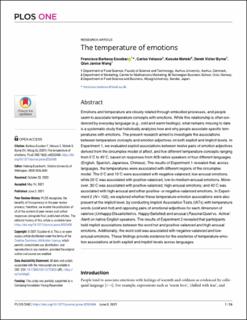| dc.description.abstract | Emotions and temperature are closely related through embodied processes, and people seem to associate temperature concepts with emotions. While this relationship is often evidenced by everyday language (e.g., cold and warm feelings), what remains missing to date is a systematic study that holistically analyzes how and why people associate specific temperatures with emotions. The present research aimed to investigate the associations between temperature concepts and emotion adjectives on both explicit and implicit levels. In Experiment 1, we evaluated explicit associations between twelve pairs of emotion adjectives derived from the circumplex model of affect, and five different temperature concepts ranging from 0°C to 40°C, based on responses from 403 native speakers of four different languages (English, Spanish, Japanese, Chinese). The results of Experiment 1 revealed that, across languages, the temperatures were associated with different regions of the circumplex model. The 0°C and 10°C were associated with negative-valanced, low-arousal emotions, while 20°C was associated with positive-valanced, low-to-medium-arousal emotions. Moreover, 30°C was associated with positive-valanced, high-arousal emotions; and 40°C was associated with high-arousal and either positive- or negative-valanced emotions. In Experiment 2 (N = 102), we explored whether these temperature-emotion associations were also present at the implicit level, by conducting Implicit Association Tests (IATs) with temperature words (cold and hot) and opposing pairs of emotional adjectives for each dimension of valence (Unhappy/Dissatisfied vs. Happy/Satisfied) and arousal (Passive/Quiet vs. Active/Alert) on native English speakers. The results of Experiment 2 revealed that participants held implicit associations between the word hot and positive-valanced and high-arousal emotions. Additionally, the word cold was associated with negative-valanced and low-arousal emotions. These findings provide evidence for the existence of temperature-emotion associations at both explicit and implicit levels across languages. | en_US |
